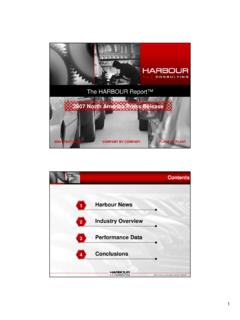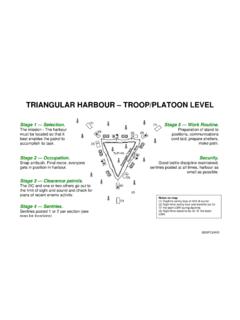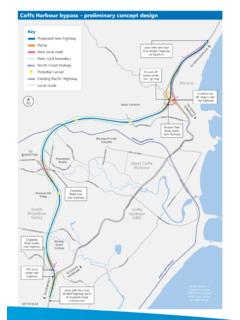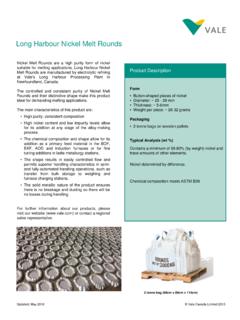Transcription of TMA BEST PRACTICE GUIDELINES – NAVIGATING …
1 Disclaimer: this content is provided on an "as is" basis for general information purposes only and is not intended to constitute or substitute legal or other professional advice. You must make your own assessment of the information contained in this guide and rely on it wholly at your own risk. You should not take any actions based on this guide without seeking legal advice. To the extent permitted by applicable law, all representations, warranties and other terms are excluded. This guide is tailored to the considerations that may be relevant in the medium to large enterprise sector, and in particular for entities with a turnover of more than $10 million. Different considerations are likely to be more relevant to smaller enterprises. TMA best PRACTICE GUIDELINES NAVIGATING SAFE HARBOUR Conduct initial assessment of financial position Available Steps Phase Objective Assess availability of Safe Harbour and resolve to enter Develop and approve a turnaround plan Implement turnaround plan and monitor performance regularly Assess the success or failure of the course of action taken Engage "appropriately qualified entity/entities"* Form a turnaround committee of key stakeholders (if appropriate) Enter into standstill arrangements with key creditors (if required) Hold regular board meetings where the course(s) of action are reviewed and monitored against milestones Directors seek legal, strategic and financial advice, as appropriate Assess threshold issues: is the company able to pay employee entitlements and comply with tax reporting obligations?
2 Directors form an initial view on whether the company is solvent or at risk of insolvency assessment of financial status of company by directors and advisorsEvidence Outputs Taking action Planning course(s) of action Assessing and entering Safe Harbour Phase Starting to suspect insolvency/risk of insolvency engagement of appropriately qualified that threshold issues are recommendation on Safe resolution to implementSafe Harbour (if appropriate)Leaving Safe Harbour plan documented, including better outcome opinion stakeholder views(if appropriate) resolution to implementthe timetable andresponsibilities for board meeting minutes which document continuedconsideration of against forecastfinancial reporting to stakeholders and market Company must manage key stakeholders and maintain appropriate financial records Implement crisis stabilisation and cash management processes (if appropriate) Formulate the turnaround plan.
3 Advisors provide a written "better outcome" opinion on proposed course(s) of action Determine whether a standstill period can be agreed with financiers/ key creditors Directors must continue to comply with all their general law and statutory duties, including financial monitoring Company must comply with continuous disclosure obligations (if applicable) and continue to pay employee entitlements and satisfy tax reporting obligations Obtain stakeholder approval of plan (if required). Pass board resolution approving the plan (if appropriate) Change course(s) of action if necessary The company avoids incurring fresh debt Advisors form a view on availability of Safe Harbour. Board passes a resolution to implement Safe Harbour (if appropriate) Assess whether the company is solvent and has achieved long-term viability or whether a formal insolvency appointment or solvent wind down is required Directors document steps taken through board meetings, file notes and records of advice Urgently take steps to address any officer/employee misconduct Directors consider insurance position (if appropriate) *Who is an "appropriately qualified entity"?
4 The legislation does not specify who will constitute an "appropriately qualified entity". In the TMA's view, the following qualifications should be held: expertise in the operational,management, financial and legalaspects of a restructuring; tertiary qualifications (or their equivalent) in turnaround; demonstrable turnaround/ restructuringexperience; and compliance with the code of ethics andprofessional development requirementsof the person's relevant Certified Turnaround Professional accredited members of the TMA meet these standards. The company may be best served by a combination of professionals, including registered liquidators, lawyers, accountants and/or investment bankers. The turnaround plan must be implemented within a reasonable period, having regard to the size and nature of the business. The above visual aid is not necessarily meant to represent a linear structure.
5 The process outlined in this guide should unfold as efficiently as possible. In this regard, it may be appropriate for some actions to occur contemporaneously. Timing Disclaimer: this content is provided on an "as is" basis for general information purposes only and is not intended to constitute or substitute legal or other professional advice. You must make your own assessment of the information contained in this guide and rely on it wholly at your own risk. You should not take any actions based on this guide without seeking legal advice. To the extent permitted by applicable law, all representations, warranties and other terms are excluded. This guide is tailored to the considerations that may be relevant in the medium to large enterprise sector, and in particular for entities with a turnover of more than $10 million. Different considerations are likely to be more relevant to smaller enterprises.
6 Assessment of solvency The directors must undertake an initial assessment of whether the company is insolvent or at risk of becoming insolvent. Time is of the essence in doing so. The test for determining whether a company is solvent is whether the company is able to meet its debts as and when they fall due. This is a cash flow test rather than a balance sheet test. Independent legal and financial advice are recommended at this stage. The board should defer incurring any fresh debts or expenses and avoid renewing any leases at least until a decision on the appropriateness of Safe Harbour is reached in the following phase. The steps taken for the solvency assessment should be carefully documented through board minutes, file notes and records of advice. This is important because Safe Harbour may be taken to apply as early as when the directors start deliberating on the course(s) of action.
7 Consideration should be given to disclosure and notification obligations under any relevant directors' and officers' insurance policies, if applicable. Resolving to enter Safe Harbour If the board has determined that the company is insolvent (or at risk of insolvency), it must now decide on whether Safe Harbour is available or whether to invoke a formal insolvency process, such as voluntary administration. If independent legal and financial advice has not yet been sought by the company, such advisors should now be formally engaged. The advice of an "appropriately qualified entity"* is one of the matters on which the Court will look favourably when assessing whether Safe Harbour was properly available to the directors. The board and advisors must consider whether the company can satisfy the conditions for Safe Harbour.
8 In particular, Safe Harbour is not available if the company is unable to pay employee entitlements and/or comply with its tax reporting obligations. The disposition of key stakeholders (and in particular financiers) towards standstill arrangements may need to be confirmed, to assess the possibility of action/security enforcement which may adversely affect any Safe Harbour period. Any concerns that misconduct by officers or employees of the company is occurring that could adversely affect the company s ability to pay all its debts should be urgently addressed concurrently with this assessment process. The advisor(s) should, based on all available circumstances prevailing at the time, provide a view to the board as to whether Safe Harbour is available to the company. The board should carefully consider whether Safe Harbour is available to the company and make an appropriate resolution having regard to the advice.
9 Turnaround Planning Once the board has resolved that Safe Harbour is available, standstill arrangements with key lenders and other creditors may need to be pursued to give the company time to develop and implement a turnaround plan. If appropriate, crisis stabilisation, including aggressive cash management, should also begin immediately. Communication with financiers is usually critical in turnaround situations. Serious consideration should be given to communicating with key financiers and continued engagement with them during the period of Safe Harbour. The turnaround plan be formulated and it should address operational, strategic and financial issues. The turnaround plan may comprise of one or more courses of action, depending on what is reasonably likely to lead to a better outcome for the company.
10 The plan should contain a clear set of steps required to implement the proposed course(s) of action and a timetable of milestones that are capable of objective assessment. Advisors should be prepared to provide a "better outcome" opinion on the turnaround plan. This means taking a view on whether the plan is objectively likely to produce a better outcome for the company than the immediate appointment of a liquidator or administrator. The assessment of the better outcome will require careful legal and financial analysis of the individual circumstances and options. The turnaround plan should be formally adopted by board resolution, if the board is satisfied that the plan is viable and is reasonably likely to produce the requisite "better outcome" for the company. Implementation and Monitoring The turnaround should be implemented within a reasonable period and otherwise in accordance with its timetable.








